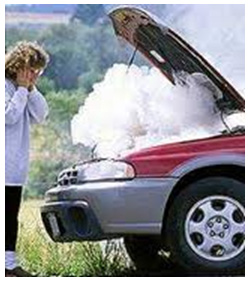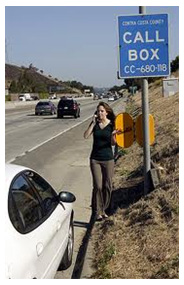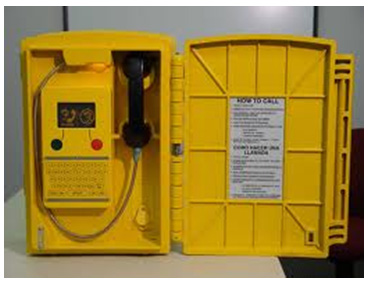A significant number of collisions are caused by vehicle equipment failure such as:

- Bald or defective tires
- Bad brakes
- Inoperative lights
- Degraded steering and suspension components.
You should keep your vehicle in good working condition and perform routine maintenance to help avoid crashes caused by mechanical failure.
You should know how to react to avoid crashes when it happens to you. The first thing to remember is to stay calm. You will be able to think more clearly and respond appropriately if you do not panic.
 If your gas pedal is stuck down, you should:
If your gas pedal is stuck down, you should:
- Shift to neutral
- Apply the brakes
- Keep your eyes on the road to look for a way out
- Warn other drivers by blinking and flashing your emergency lights
- Try to drive the car safely off the road
- Turn off your ignition when you no longer need to change direction and are stopped.
- Turn on your emergency flashers.
Note: Turning the ignition switch completely off while moving is never the correct response to an emergency situation. It may lock the steering wheel and you will be unable to steer the vehicle. Never turn your ignition off while your vehicle is still moving, no matter what sort of emergency situation you are experiencing.
If you have a tire blowout or lose a wheel while driving, you should:
Hold the steering wheel tightly and steer straight ahead. Slow down gradually by taking your foot off the gas pedal slowly but without applying the brakes. Slow to a stop off the road and apply the brakes only when the car is almost stopped. Turn on your emergency flashers.
If your brakes suddenly give out while driving, you should:
- Downshift to lower gear or lower range (automatic transmissions) to help slow your vehicle.
- Pump the brake pedal fast and hard to build up brake fluid pressure. You will know in three to four pumps if the brakes will work. Do not pump the brakes on vehicles with antilock brakes.
- Use your parking or emergency brake to gently slow your vehicle but release it before the vehicle starts to skid.
- Steer and swerve to avoid a collision or steer into something soft like bushes
- Sound your horn and flash your lights to alert other drivers.
- When you are stopped, turn off the ignition and turn on your emergency flashers.
If your brakes get wet and do not work(such as after you travel through a big puddle): Dry them by lightly pressing the gas pedal and brake pedal at the same time so that the vehicle drives against the pressure of the brakes. Do this only until the brakes begin working.
If your vehicle’s engine is running hot, you should:
- Turn off the air conditioner.
- If you are in stop and go traffic change your route so that you can get air moving over the radiator.
- Pull to the side of the road if you see steam.
- Shut off the engine, turn on your emergency flashers, open the hood and wait 20 minutes before inspecting the radiator.
- After 20 minutes, refill the radiator by pouring water or coolant into the overflow tank.
- With the hood still up, inspect for leaks and call a tow truck if you cannot fix them.
Note: Driving up on hills or mountains while using your air conditioning puts extra strain on your engine and may cause your vehicle to overheat. Use you air conditioning sparingly when driving up steep roads.
If both of your headlights go out while driving at night, you should:
- First wiggle the dimmer switch, which will often put the lights back on.
- If the lights do not come on, put on your parking lights, turn indicators or emergency flashers to warn other drivers.
- Pull off the road as quickly as possible and leave the emergency flashers on.
Note:
- You might try checking your battery terminals or fuses to see if they are loose or blown.
- Do not try driving at night with only your parking lights working or with no lights working. This is extremely dangerous even for only a short period. Also, do not attempt to use your high-beam headlights and keep driving. You will not be able to dim them for other vehicles on the roadway.
If your engine stalls while you are driving, you should:
- Turn on your emergency flashers immediately.
- Move your vehicle to the side of the road as quickly and safely as possible. Also, realize that the steering wheel may take more force to turn because the power steering won’t work
- Stop your vehicle. You may need more force on the brakes because power brakes will not work.
- Turn on your emergency flashers.
- Try to restart the engine. If the engine won’t start, call for help. Do not try to restart your engine while you are still moving.
The following are other emergency situations that do not necessarily involve mechanical failure.
Running your tires off the pavement
If you accidentally run one or more of your tires off the pavement and onto the shoulder of the roadway, do not quickly turn the steering wheel back towards the roadway. This can cause you to hook on the edge of the pavement and skid or flip your vehicle. You should ease your foot off of the gas pedal and brake gently. Slowly try to steer your vehicle back onto the pavement.
Being approached head-on by another vehicle
If a vehicle is approaching you head on and you are in the proper lane for traveling in your direction, you should:
- Slow down
- Pull to the right
- Sound your horn
Do not pull into the left (oncoming) lane, because the other driver may realize their error and swerve back into the proper lane. Remember that hitting anything else is usually better than a head-on collision with another vehicle.
Going off the road into deep water
If your vehicle goes into water such as a lake or river, you should:
- Remember that your vehicle will float for at least short period of time
- Unfasten your seatbelt and help other passengers unfasten theirs
- Escape through a window (do not open a door)
If the vehicle sinks quickly, you should climb into the back seat because an air pocket should form there. Get out as quickly as possible through a window. If you cannot get out through the window because your electric windows have shorted, open the door slowly. Note: Although it may be hard to do so at first, as water enters the vehicle, the pressure will equalize and you should be able to open the door.
Vehicle fire
If you see smoke or flames coming from your engine while you are driving, you should:
- Pull off the roadway as quickly as is safe
- Turn off the ignition and get away from the vehicle
- Call the fire department
- Do not try to put the fire out yourself because it can be very dangerous. If you have a fire extinguisher and the fire is within the passenger compartment or bed of the vehicle, you can try to put the fire out once you are stopped.
 Prevention is the best safeguard for breakdowns. Frequently check the fuel gauge, oil and other fluid levels, tire tread and pressure, engine drive belts, hoses and the radiator. Be sure the car’s stoplights, headlights, turn signals and four-way emergency flashers operate properly.
Prevention is the best safeguard for breakdowns. Frequently check the fuel gauge, oil and other fluid levels, tire tread and pressure, engine drive belts, hoses and the radiator. Be sure the car’s stoplights, headlights, turn signals and four-way emergency flashers operate properly.
If you are having car trouble and have to stop
- If at all possible, pull off the road and away from all traffic. If you cannot get completely off the road, try to stop where people can see you and your car from behind. Do not stop over a hill or around a curve.
- Turn on your emergency flashers to warn other drivers that your vehicle is broken down. If your car does not have emergency flashers, your turn signals may be used instead.
- If it is safe, raise the hood of your vehicle to signal to others that your car has broken down.
- Give other drivers plenty of warning.
- If you have them, place emergency flares or reflective triangles 200 to 300 feet behind your vehicle. This allows other drivers time to change lanes, if necessary. Be very careful when using flares because they may cause fires if used near flammables such as gasoline.
- If you don’t have emergency flares, stay in your vehicle until help arrives.
- Use a cellular phone to call for help if you have one. For your safety, stay off the roadway.
Breaking down on a busy freeway
- This can be a frightening and dangerous situation. Exit the freeway at the first sign of vehicle problem or malfunction. If you are unable to exit, try to drive safely onto the far right shoulder, as far off the road as possible. If you can’t reach the right shoulder, park as close to the center divider as you can.
- Whenever your vehicle is disabled on the roadway, use your vehicle’s hazard warning lights. Be sure you know where your vehicle’s hazard light switch is located and how to use it. Warning lights should also be used when the vehicle is in the center divider or on the right shoulder, especially if parked within five feet of the roadway.
Note: It is impossible to predict all situations as freeway traffic patterns and the hazards they present constantly vary. Therefore, it is important that drivers continually monitor and evaluate the situations and take the steps that will best protect the driver, passengers and other freeway
If stopped in the center divider, it is generally safest to remain in your vehicle until a law enforcement officer arrives.
- Keep your seatbelt fastened, headrest properly positioned and car doors locked. Do not get out and walk around the car or attempt to cross the freeway to reach the outside shoulder.
- If your vehicle is stopped in a particularly dangerous spot and traffic permits, exit the vehicle and find a safe location to wait for help. Such conditions may include a breakdown or an accident that has occurred in fog or smoke. users.
If your car has a flat tire
- Avoid making any repairs on the freeway. If you must do so, have someone keep an eye on traffic to warn you of approaching danger.
- Never turn your back on freeway traffic.
Note: It is better to safely drive off the freeway than try to salvage a tire that may already be beyond repair.
If your disabled vehicle is on any part of the roadway, use emergency flares, battery-operated or reflectorized warning devices. Exit the vehicle to place these devices only when safe. They should be placed at least 300 feet behind the car.
Note: Only persons familiar with them should use flares. They should not be placed near flammable liquids or materials. Placing any warning device in traffic can be dangerous and extreme caution must be exercised.
If your vehicle is stopped in a traffic lane, keep its wheels turned to follow the direction of the lane ahead of you. Vehicles stopped on the right or left shoulders should have the wheels pointed straight ahead.
“What to do” during a break down
- Roll down the window so you can tie a handkerchief or other cloth onto the radio antenna or the door handle closest to traffic without exiting the vehicle.
- Display an emergency sign, if available.
- If safe to exit the vehicle, do so and raise the car’s hood as a signal you need help. Ext the vehicle on the side away from traffic.

- If your vehicle will be left unattended, turn off the engine and take your keys. Set the parking brake.
- In California and many other states, freeway call boxes are located at intervals on the right shoulder of the freeway.
- The telephone is found in a bright yellow box.
- A blue “Call Box” sign is mounted above the yellow box.
- The numerals on the blue sign indicate the freeway’s route and call box location.
- Use a call box only if it can be reached without crossing traffic lanes, on/off ramps or transition roads.
- Walk only on the shoulder area as far away from traffic as possible.
- Always face traffic while using a call box.
- See and be seen by oncoming traffic.
How to Use a Call Box
1. Open the call box, lift the receiver and push the button to initiate your call for assistance.
2. No money is needed to use it. Wait for the ring. You will hear equipment automatically dialing and then ringing the switchboard.
3. In California, the California Highway Patrol operator will answer the call.
4. If circuits are busy, a recording will advise you to stay on the line. Don’t hang up. Waiting calls are taken in order.
5. If you hear a busy signal without the recording, hang up and try again.
6. When the operator answers, be prepared to give the call box identification numbers (on the sign above the box), the nature of your trouble and your vehicle’s location.
7. Upon request, the operator will phone your automobile club, a family member, friend, insurance company or other service for emergency assistance.
8. Once your call is completed, make sure the receiver is properly replaced to leave the circuit free for other callers.
- If your car is in a particularly dangerous spot, it may be safer to stay near the call box or go to another area such as behind a guardrail near your vehicle.
- If it is safe, wait with your vehicle. Remain inside with your safety belt fastened, with the headrest properly positioned and doors locked until help arrives.
- If a friend or relative comes to help, make sure they park 100 to 200 feet in front of the disabled vehicle to leave room for the tow truck. Do not stand between two vehicles at any time. Wait in the other vehicle with safety belts fastened and head rests properly positioned. Make sure the wheels of the vehicle are pointed straight ahead. When the tow truck arrives, wait in it, not in your vehicle.

